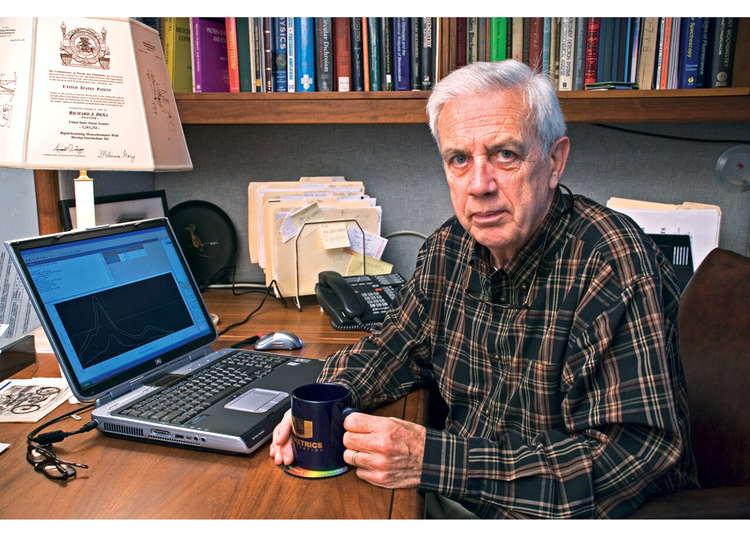The Buzz on Uv/vis/nir
The Buzz on Uv/vis/nir
Blog Article
The Ultimate Guide To Spectrophotometers
Table of ContentsWhat Does Uv/vis/nir Mean?The Ultimate Guide To Uv/visUv/vis - TruthsNot known Facts About Uv/visCircularly Polarized Luminescence Can Be Fun For Anyone

Spectrophotometry is most typically applied to ultraviolet, noticeable, and infrared radiation, modern spectrophotometers can interrogate broad swaths of the electro-magnetic spectrum, including x-ray, ultraviolet, noticeable, infrared, and/or microwave wavelengths. Spectrophotometry is a tool that depends upon the quantitative analysis of particles depending on just how much light is taken in by colored compounds.
Circular Dichroism Can Be Fun For Everyone
A spectrophotometer is commonly utilized for the measurement of transmittance or reflectance of options, transparent or opaque solids, such as refined glass, or gases. Although lots of biochemicals are colored, as in, they take in visible light and for that reason can be determined by colorimetric treatments, even colorless biochemicals can typically be transformed to colored substances appropriate for chromogenic color-forming reactions to yield compounds ideal for colorimetric analysis.: 65 Nevertheless, they can also be designed to measure the diffusivity on any of the noted light ranges that generally cover around 2002500 nm utilizing different controls and calibrations.
An example of an experiment in which spectrophotometry is utilized is the decision of the balance constant of a service. A certain chemical reaction within an option might occur in a forward and reverse instructions, where reactants form products and products break down into reactants. At some time, this chemical reaction will reach a point of balance called a balance point.
Some Known Facts About Circular Dichroism.
The quantity of light that goes through the service is indicative of the concentration of particular chemicals that do not allow light to go through. The absorption of light is due to the interaction of light with the electronic and vibrational modes of molecules. Each kind of particle has a specific set of energy levels related to the makeup of its chemical bonds and nuclei and hence will soak up light of specific wavelengths, or energies, leading to special spectral residential or commercial properties.
Making use of spectrophotometers spans numerous scientific fields, such as physics, materials science, chemistry, biochemistry. UV/Vis/NIR, chemical engineering, and molecular biology. They are widely used in lots of markets including semiconductors, laser and optical manufacturing, printing and forensic examination, as well as in laboratories for the study of chemical substances. Spectrophotometry is frequently utilized in measurements of enzyme activities, determinations of protein concentrations, decisions of enzymatic kinetic constants, and measurements of ligand binding reactions.: 65 Ultimately, a spectrophotometer is able to determine, depending on the control or calibration, what compounds are present in a target and precisely just how much through computations of observed wavelengths.
Invented by Arnold O. Beckman in 1940 [], the spectrophotometer was created with the aid of his associates at his company National Technical Laboratories established in 1935 which would end up being Beckman Instrument Business and eventually Beckman Coulter. This would come as a solution to the formerly produced spectrophotometers which were unable to take in the ultraviolet properly.
Not known Factual Statements About Circularly Polarized Luminescence
It would be found that this did not provide satisfactory outcomes, therefore in Model B, there was a shift from a glass to a quartz prism which enabled for much better absorbance outcomes - circular dichroism (https://urlscan.io/result/3823bc3a-74b6-4d0f-8f09-522e983b4d26/). From there, Design C was born with a change to the wavelength resolution which ended up having 3 units of it produced
It irradiates the sample with polychromatic light which the sample absorbs depending upon its properties. It is transmitted back by grating the photodiode range which discovers the wavelength area of the spectrum. Ever since, the development and execution of spectrophotometry devices has increased exceptionally and has actually turned into one of the most innovative instruments of our time.

Circular Dichroism - Questions
Historically, spectrophotometers utilize a monochromator containing a diffraction grating to produce the analytical spectrum. The grating can either be movable or fixed. If a single detector, such as a photomultiplier tube or photodiode is used, the grating can be scanned step-by-step (scanning spectrophotometer) so that the detector can measure the light strength at each wavelength (which will represent each "action").
In such systems, the grating is repaired and the strength of each wavelength of light is determined by a various detector in the variety. In addition, most modern-day mid-infrared spectrophotometers utilize a Fourier change strategy to acquire the spectral details - https://www.startus.cc/company/olis-clarity. This strategy is called Fourier change infrared spectroscopy. When making transmission measurements, the spectrophotometer quantitatively compares the portion of light that travels through a reference service and a test option, then electronically compares the intensities of the two signals and calculates the percentage of transmission of the sample compared visit this web-site to the referral standard.

Report this page